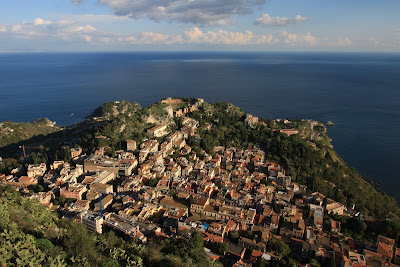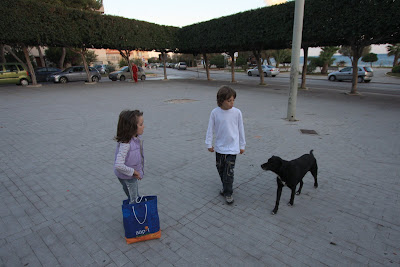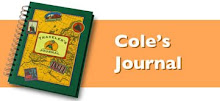We spent our next ten days on the island of Sicily, which is technically still a part of Italy. I offer hesitation here because the people refer to themselves as Sicilian (before Italian). They also speak Sicilian, a language influenced by, but not derived from Italian. Aside from the language, we came across many differences during our stay, from the local customs, to the food, and even the terrain. Arriving late on the ferry, our first taste of Sicily got us as far as the deserted summer beach resort of Brolo. After a quick night's sleep we headed into Cefalu the next morning.


Here's a shot on our way out of Cefalu. You can see here how the cathedral dominates the town.

After lunch in was on to Palermo. Our plan was to stay on the outskirts of Palermo where we could catch a train in for the day, thus avoiding the city traffic. One thing led to another however, and we found ourselves driving in the heart of Palermo at rush hour. Palermo is Italy’s 5th largest city with well over one million people, and known for its crazy drivers. The amount of traffic I can handle, but it’s the fact that no one follows any sort of rules that becomes unnerving. Lines to divide lanes don’t exist, and a street that would normally be 4 lanes somehow fits 6. The traffic signs and lights are considered "mere suggestions". Overall we found Palermo to be a lot like Naples, except grittier. (We found out later that in 1816 The Kingdom of Sicily was united with The Kingdom of Naples to form Two Sicilies, until all of Italy was united in 1860.) Like in Naples, the guidebooks, local tourist office, and our hotel front desk, all advised us to use caution when visiting and avoid certain parts of town. Although they are trying to fix up the city, this is a town that has been under the stranglehold of the mafia for many, many years. It seems that everything you inquire about somehow ties back to a mafia story, but more on that in another post.





Our hotel was very nice and located in the heart of Palermo. We looked out over the harbor and Cole loved watching the ships come and go. But if you looked out a window from the other side of the hotel, it was a completely different story.

The Palermo Duomo

After two nights in Palermo it was off to Agrigento. This time we detoured to Corleone, the one town more closely associated with the mob than any other. (But again, more on that in the next post.) Agrigento is best known for
The Valley of the Temples, an area full of Greek temples and ruins. (The island of Sicily actually sports more Greek temples than Greece itself.) Despite the name of this site, the temples actually stand along a ridge and not in a valley, allowing them to be seen from all sides. Each temple was constructed to face east, so that the statue of the God it was dedicated too, would be illuminated by the rising sun each day. After a few hours strolling through the archeological zone we headed into town for some dinner. Surprisingly the old town was very quaint with a beautiful pedestrian area to wander and shop. It was actually the first bit of normalcy we’d had since the Amalfi Coast.

Like in Paestum, here is another temple built for Hera, goddess of marriage and woman.

Five of the remaining pillars from the Temple of Hercules, built in the 6th century BC.


Cole hanging out amongst some of the fallen pillars.

We stopped back at night for a different perspective. Here again is the Temple of Concord, built 440BC.

After breakfast the next morning and a 2 ½ hour drive we found our next stop, Siracusa (Syracuse in English). The old town is actually an island connected by 3 bridges, all sitting in a row. Once the most powerful Greek city in the Mediterranean, today it's a quiet little town bustling with locals and tourists. We especially loved the Duomo here that has managed to record the many ages of the town. The massive cathedral was actually built over the top of a 5th century BC temple dedicated to the god Athena. Instead of demolishing the ancient temple, they actually incorporated it into the construction and to this day the original columns are all visible parts of the walls. Additions over the years, right up to the 18th century façade, made this church unlike any other we've seen . After a night at Casa Mia (our Mia was very excited), we headed towards our last stop on the circle tour, Taormina. Here we would have five nights giving us a chance to catch our breath.

Here's a look down one of the church corridors. You can see some of the old temple columns on the left which are still a part of the exterior walls.

Trinacria is both an alternative name for Sicily and its national symbol which appears on its flag. The symbol shows Medusa's snake haired head, adorned with wheat. Medusa was in charge of protecting the ends of the earth, which in the days of ancient Greece meant Sicily. The wheat represents cultivation of the fertile soil and the three legs stand for the 3 corners of the triangular island. The leg bent at the knee was a Spartan symbol of power.

One of the squares in Siracusa.

 After working our way around the island, we had the next five days to relax in Taormina. The extra couple of days would also give us a chance to catch up on the kid’s schoolwork. More than the other towns we visited, Taormina felt like we were back in northern Italy. Here you’re much more likely to run into a few tour buses and some fellow Americans. The city is beautifully perched on the cliffs, offering views up and down the coast, across to mainland Italy, and up the slopes of Mt. Etna. The main cultural attraction here is the Greek theatre, which is perched on a cliff in the best spot in town. Built by the Greeks in the 3rd century BC, it was later enlarged under Roman rule in the 2nd century AD. Thought to originally seat 5,400 spectators, it still packs them in today hosting numerous events throughout the year. Although no event was scheduled for the day we visited, a soul choir from Nashville happened to be visiting at the same time and decided to sing a few numbers from the historic stage. We certainly enjoyed our impromptu concert.
After working our way around the island, we had the next five days to relax in Taormina. The extra couple of days would also give us a chance to catch up on the kid’s schoolwork. More than the other towns we visited, Taormina felt like we were back in northern Italy. Here you’re much more likely to run into a few tour buses and some fellow Americans. The city is beautifully perched on the cliffs, offering views up and down the coast, across to mainland Italy, and up the slopes of Mt. Etna. The main cultural attraction here is the Greek theatre, which is perched on a cliff in the best spot in town. Built by the Greeks in the 3rd century BC, it was later enlarged under Roman rule in the 2nd century AD. Thought to originally seat 5,400 spectators, it still packs them in today hosting numerous events throughout the year. Although no event was scheduled for the day we visited, a soul choir from Nashville happened to be visiting at the same time and decided to sing a few numbers from the historic stage. We certainly enjoyed our impromptu concert.

 From inside the theatre you can see the line of smoke from the summit of Mt. Etna. It was billowing smoke all week.
From inside the theatre you can see the line of smoke from the summit of Mt. Etna. It was billowing smoke all week. After a little schoolwork in the morning, what a great place for recess.
After a little schoolwork in the morning, what a great place for recess. Another one of our day trips took us out to investigate Mt. Etna. Standing about 11,000 feet tall (2 ½ times that of Mt. Vesuvius near Pompeii), it is one of the most active volcanoes in the world. It has already erupted several times since the year 2000, but the locals seem to just look up and yawn. Over the years Mt. Etna has produced countless summit eruptions and 60 flank eruptions. The flank eruptions are the dangerous ones, as they can pop up in or near more populated areas along the slopes. Since the year 2000 there have been 4 explosive flank eruptions sending ash as far as Libya. Currently they are dealing with one of the longest lasting eruptions. While it is only producing a very slow lava flow, the volcano has been erupting since May 13 of this year. When we arrived at the top (at least as far as cars can travel) we inquired about taking one of the tours. We were then informed that due to “unpredictable conditions”, all excursions for the next 2 weeks had been cancelled. So instead we climbed around some of the extinct flank craters, this one from a 1986 eruption.
Another one of our day trips took us out to investigate Mt. Etna. Standing about 11,000 feet tall (2 ½ times that of Mt. Vesuvius near Pompeii), it is one of the most active volcanoes in the world. It has already erupted several times since the year 2000, but the locals seem to just look up and yawn. Over the years Mt. Etna has produced countless summit eruptions and 60 flank eruptions. The flank eruptions are the dangerous ones, as they can pop up in or near more populated areas along the slopes. Since the year 2000 there have been 4 explosive flank eruptions sending ash as far as Libya. Currently they are dealing with one of the longest lasting eruptions. While it is only producing a very slow lava flow, the volcano has been erupting since May 13 of this year. When we arrived at the top (at least as far as cars can travel) we inquired about taking one of the tours. We were then informed that due to “unpredictable conditions”, all excursions for the next 2 weeks had been cancelled. So instead we climbed around some of the extinct flank craters, this one from a 1986 eruption.
 This is a view from Taormina at night. You can see the lava flowing (from the flank crater) just above one of the mountain villages. Cole thought that was pretty awesome and even the girls were fired up.
This is a view from Taormina at night. You can see the lava flowing (from the flank crater) just above one of the mountain villages. Cole thought that was pretty awesome and even the girls were fired up.
 But what started as a relaxing finish to Sicily, quickly turned into a bit of chaos. On Thursday night we got an email saying our Saturday ferry from Catania (just down the coast) to Malta was going to be cancelled due to high winds in the forecast. We were told to either divert to Pozzallo (in south Sicily) by the next night, or risk being stranded for what could be 3 or 4 extra days. After sleeping on it we decided we'd better make a run for Pozzallo. We quickly started packing around 8:30 and then hiked the 2km to our car park. From there we drove to Catania to return the rental car at the airport, took a bus from the airport to the train station, took a train from Catania to Siracusa, and then another from Siracusa to Pozzallo. When we stepped off the train in Pozzallo it was dead quiet, not another person in sight, and I was beginning to question whether or not this could be the right town. Thankful that it was still daylight, we started walking and waved down the first car we saw. The driver, speaking only Italian, pointed us towards town and off we went. After our first kilometer, a black lab took a liking to us and offered to lead the pack. It sounds like I'm making this up, but he literally got in front and lead us (for at least another kilometer) right through town. He barked almost the entire way as if to clear the road, and dropped us off at the ferry office front door. People were coming out of their stores and almost laughing at us as we all paraded down main street with our bags in tow. Overall Malta is not that much further south than Taormina, but as we pulled into the Malta harbor 13 hours later, it felt like worlds away.
But what started as a relaxing finish to Sicily, quickly turned into a bit of chaos. On Thursday night we got an email saying our Saturday ferry from Catania (just down the coast) to Malta was going to be cancelled due to high winds in the forecast. We were told to either divert to Pozzallo (in south Sicily) by the next night, or risk being stranded for what could be 3 or 4 extra days. After sleeping on it we decided we'd better make a run for Pozzallo. We quickly started packing around 8:30 and then hiked the 2km to our car park. From there we drove to Catania to return the rental car at the airport, took a bus from the airport to the train station, took a train from Catania to Siracusa, and then another from Siracusa to Pozzallo. When we stepped off the train in Pozzallo it was dead quiet, not another person in sight, and I was beginning to question whether or not this could be the right town. Thankful that it was still daylight, we started walking and waved down the first car we saw. The driver, speaking only Italian, pointed us towards town and off we went. After our first kilometer, a black lab took a liking to us and offered to lead the pack. It sounds like I'm making this up, but he literally got in front and lead us (for at least another kilometer) right through town. He barked almost the entire way as if to clear the road, and dropped us off at the ferry office front door. People were coming out of their stores and almost laughing at us as we all paraded down main street with our bags in tow. Overall Malta is not that much further south than Taormina, but as we pulled into the Malta harbor 13 hours later, it felt like worlds away.











































